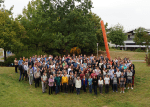Although the South Pole is essentially a desert, a hefty accumulation of snow occurs on and around the buildings there each winter. How is that? Well, it’s the wind. Antarctica is a windy place—even with so little precipitation, it features some extraordinary blizzards thanks to strong winds. […]
News
Neutrinos and gamma rays, a partnership to explore the extreme universe
IceCube’s collaborative efforts with gamma-ray, X-ray, and optical telescopes started long ago. Now, the IceCube, MAGIC and VERITAS collaborations present updates to their follow-up programs that will allow the gamma-ray community to collect data from specific sources during periods when IceCube detects a higher number of neutrinos. Details of the very high energy gamma-ray follow-up program have been submitted to the Journal of Instrumentation. […]
Week 39 at the Pole
With the sun out, you can see again—and here we see all the flags surrounding the marker at the ceremonial pole. They didn’t just appear out of the darkness, though. They were recently replaced for the summer season after being taken down for the winter. […]
Week 38 at the Pole
Flags serve an important purpose at the Pole, marking out routes between places for when visibility is poor. Here you can see the IceCube Lab (ICL) in focus behind a flag line in the foreground. […]
IceCube Collaboration wraps up in Mainz, Germany
The IceCube Collaboration fall 2016 meeting ends today at Johannes Gutenberg Universität Mainz in Germany. Professors Sebastian Böser and Lutz Köpke hosted the weeklong meeting.
“It’s been a total thrill to see how fast we as a collaboration are moving forward on so many fronts in parallel,” says Sebastian Böser. “I hope everyone has enjoyed the meeting in Mainz as much as we’ve enjoyed hosting the collaboration.” […]
Week 37 at the Pole
Up, up, and away. That’s a NOAA balloon launch shown in a time-lapse photo—pretty nice! Last week at the Pole was all about the camera. […]
Week 36 at the Pole
A new temperature record for 2016 was set at the Pole last week—a low of –107.9 °F. The extremely cold temperatures didn’t stop one station inhabitant from climbing the outdoor staircase is short sleeves. […]
Searching for point-like sources with seven years of IceCube data
The IceCube Collaboration has just announced the results of a search for point-like sources using track-like neutrino candidates detected by IceCube over seven years, from 2008 to 2015. No source has been identified, but the sensitivity keeps improving at a fast pace and will allow IceCube to test accurate models that suggest that sources could soon be observed. These results have just been submitted to The Astrophysical Journal. […]
Week 35 at the Pole
One unique aspect of living at the Pole for a year is experiencing only one sunset, at the equinox in March, and only one sunrise, which occurs in September, while you’re there. Since the sun rises just once during the whole year, it’s kind of a big deal. It’s also a slow process, with daylight increasing little by little as the sun’s arrival nears. […]
Week 34 at the Pole
Despite the encroaching twilight, this photo of a Scott tent near the South Pole marker also captured some faint auroras. Auroras have been caught in many shapes and forms, conjuring up cinnamon rolls and question marks, but in this case, it’s a grumpy face. At least, once it has been suggested, it’s difficult not to see it. […]









